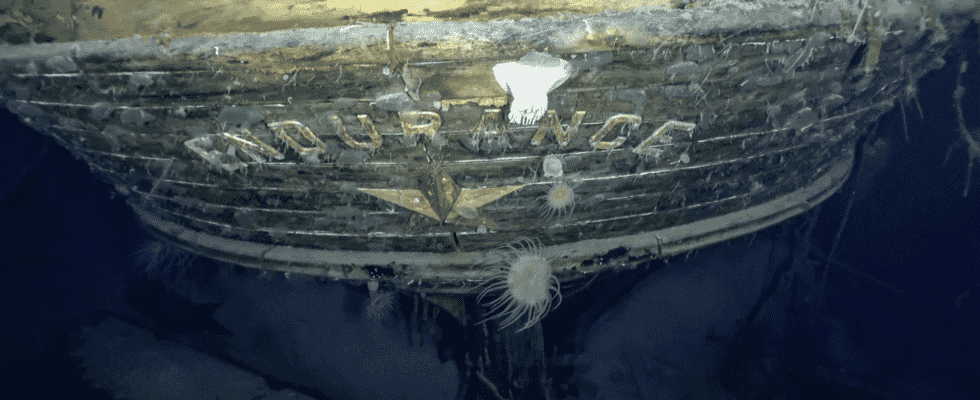It is a mythical wreck that has resurfaced. The Endurance, the ship of British explorer Ernest Shackleton, caught in the ice of Antarctica in 1915, was found this Wednesday, March 9, in the Weddell Sea at 3,000 meters deep.
“We are very moved to have located and captured images of the Endurance,” Endurance 22 expedition director Mensun Bound said in a press release.
Considered the “most inaccessible wreck in the world” due to its geographical location, the British explorer’s ship was finally discovered after two weeks of research.
In “perfect state” of conservation
And the first underwater images taken of Sir Ernest Shackleton’s ship, buried in the Weddell Sea off the east coast of the Antarctic Peninsula, are extraordinary as the wreckage is in “perfect condition” of preservation, more a century after its sinking in 1915. And this, due to the total absence of oxygen.
Endurance has been found.
Discovered at 3000 meters on 5 March 2022
100 years to the day since Shackleton was buried#Endurance22 pic.twitter.com/Edvc4nzl01
— Dan Snow (@thehistoryguy) March 9, 2022
The Endurance was found at a depth of 3,008 meters and approximately six kilometers south of the position initially recorded at the time of the sinking.
“This is by far the most beautiful timber wreck I have ever seen. She stands tall, very proud on the seabed, intact, in a fantastic state of preservation,” said the exploration team, Endurance 22, on Twitter.
The most wanted boat in the UK
The British expedition, which numbered nearly a hundred people, left Cape Town on February 5 aboard a latest-generation South African icebreaker, the SA Agulhas II, in the hope of putting the hand on the “Endurance” before the end of the austral summer, next April.
Funded to the tune of 10 million euros by an anonymous donor, this mission, dubbed Endurance 22, used advanced technologies, in particular two latest-generation underwater drones to explore the depths of “the worst part of the worst sea of the world”, as Shackleton himself described it. And this, because of the thick ice that covers the sea and makes it impassable.
And this is not the first time that a team of scientists has gone in search of Sir Ernest Shackleton’s legendary ship. The previous mission dates from 2019 and had not made it possible to get our hands on it.
A legendary expedition
What makes this wreck famous today is above all the story of its captain, the Briton Ernest Shackleton. By the end of 1914, the expedition aboard the Endurance had left the British island of South Georgia in the South Atlantic. His goal: to make the first crossing on foot of the Antarctic continent, from the Weddell Sea to the Roos Sea, via the South Pole.
However, in January 1915, the ship was caught in the ice, not far from the Larsen Ice Shelf. Imprisoned for months, the hull of the 44-meter three-master broke and eventually sank in November 1915.
While part of the crew had left for the Island of Elephants, an inhospitable mountainous “rock”, Ernest Shackleton and five other sailors had undertaken a journey of more than 1,300 km aboard a lifeboat in order to reach the South Georgia whaling station, where they hoped to find rescue. At the end of this crazy crossing, the entire crew was found safe and sound, and Ernest Shackleton has since become a national hero.
The “Endurance” protected
The wreck of the “Endurance” will never be reassembled. It will remain where it was discovered under the International Antarctic Treaty, as one of the expedition members said on Twitter.
“Nothing was touched on the wreckage. Nothing has been recovered. It is protected by the Antarctic Treaty”, explains Dan Snow because it is now considered a historic site and monument.
We have super high definition film of the wreck, multi beam sonar and a hugely accurate laser model. Nothing has been touched or retrieved. #Endurance22 is coming home. pic.twitter.com/TWneqHkXCo
— Dan Snow (@thehistoryguy) March 9, 2022
Thanks to this Treaty, signed on December 1, 1959 and entered into force in 1961, Antarctica is today the only region in the world reserved for peace, science and the protection of the environment. Consequently, the text prohibits all activities of a military or commercial nature. No territorial claim is also authorized on this territory, located south of the 60th parallel. Conversely, it encourages research and scientific cooperation.
Day 30: Yesterday we had the last out of 17 ice stations. When we head north tonight, I’ll bring 630 #ice and #snow samples of 24 ice cores with me – an incredible number! I am just grateful for getting so unique insights into #Antarcric sea ice again. #endurance22 @AWI_Media pic.twitter.com/B6jWELUKq1
— Stefanie Arndt (@arndt_st) March 7, 2022
Moreover, the scientists of the Endurance 22 mission also took advantage of the mission to study the effects of climate change. Stefanie Arndt, researcher at the Alfred-Wegener Institute in Germany, said on Twitter that she had collected “an incredible number” of 630 ice and snow samples, which will soon be analyzed.
